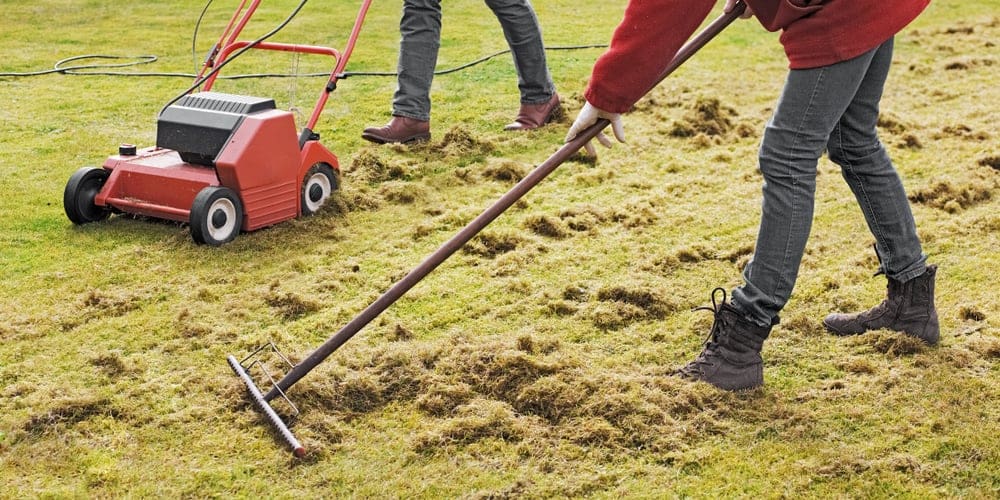Best Time to De-Thatch Lawns in Bowmanville, Oshawa, and Whitby, Ontario
Call Now
A lush, green lawn is the pride of any homeowner in Bowmanville, Oshawa, and Whitby, Ontario. To achieve and maintain such a lawn, one crucial practice is de-thatching. De-thatching involves removing the thatch layer, a dense accumulation of dead grass, roots, and organic matter that can build up on your lawn's surface.
While de-thatching is essential for lawn health, choosing the right time to perform this task is equally important. We will discuss the ideal timing and frequency for de-thatching your lawn in these Ontario regions, considering factors like grass type and climate conditions. Whether for routine lawn maintenance or seasonal cleanups, you’ll know when you schedule services after reading this.
Understanding Thatch and Its Impact
 While some thatch is natural and beneficial, excessive thatch can create problems for your lawn. Here's how thatch affects your grass:
While some thatch is natural and beneficial, excessive thatch can create problems for your lawn. Here's how thatch affects your grass:
- Poor Water Infiltration: Excessive thatch can prevent water from penetrating the soil, leading to poor water absorption and runoff.
- Reduced Nutrient Availability: Thatch can impede the movement of nutrients to the grassroots, leading to nutrient deficiencies in your grass.
- Increased Pest and Disease Risk: Thatch creates a habitat for pests and diseases, making your lawn more susceptible to infestations.
- Limited Root Growth: Thick thatch restricts root growth and can lead to shallow root systems, making grass less drought-tolerant.
- Surface Compaction: Thatch compacts over time, creating a barrier that prevents air from reaching the soil, which is vital for root health.
 The frequency of de-thatching depends on the rate of thatch buildup in your lawn. In Bowmanville, Oshawa, and Whitby, Ontario, it's common to de-thatch for cool-season grasses every 1 to 2 years and as needed for warm-season grasses.
Regular garden maintenance practices, such as proper mowing and watering, can also help reduce thatch buildup and extend the time between de-thatching.
De-thatching is a critical lawn care practice for maintaining a healthy and vibrant lawn in Bowmanville, Oshawa, and Whitby, Ontario. The ideal timing for de-thatching depends on factors like grass type and local climate conditions.
Whether you choose to de-thatch in the spring or fall, understanding the unique needs of your lawn will ensure that you remove thatch effectively and promote a beautiful and resilient property throughout the seasons. Contact a local landscaping maintenance team for further tips.
The frequency of de-thatching depends on the rate of thatch buildup in your lawn. In Bowmanville, Oshawa, and Whitby, Ontario, it's common to de-thatch for cool-season grasses every 1 to 2 years and as needed for warm-season grasses.
Regular garden maintenance practices, such as proper mowing and watering, can also help reduce thatch buildup and extend the time between de-thatching.
De-thatching is a critical lawn care practice for maintaining a healthy and vibrant lawn in Bowmanville, Oshawa, and Whitby, Ontario. The ideal timing for de-thatching depends on factors like grass type and local climate conditions.
Whether you choose to de-thatch in the spring or fall, understanding the unique needs of your lawn will ensure that you remove thatch effectively and promote a beautiful and resilient property throughout the seasons. Contact a local landscaping maintenance team for further tips.

Aaron grew up in Bowmanville, working along side his dad for as long as he can remember. Aaron went to school to get his small engine repairs certificate to help keep all the machines running well. Aaron is very knowledgeable with all lawn care needs. He took and passed the pesticide license course so he could better help his customers. Aaron always makes sure to determine what your lawn needs and can give recommendations on how to make it better.
Mr. Trim has many awards from, three best rated, This Week Readers Choice, Durham Region Readers Choice and more. Both owners Lisa & Aaron have their pesticide licences. Their biggest accomplishment of all is having loyal customers that trust them year after year for all their lawn, garden and snow clearing needs.
